- Home
- Carl Sagan
Broca's Brain Page 7
Broca's Brain Read online
Page 7
Forty years after the first “manifestations,” provoked by an uneasy conscience, Margaret Fox produced a signed confession. The raps were made—in a standing position with no apparent effort or movement—by cracking the toe and ankle joints, very much like cracking knuckles. “And that is the way we began. First, as a mere trick to frighten mother, and then, when so many people came to see us children, we were ourselves frightened, and for self-preservation forced to keep it up. No one suspected us of any trick because we were such young children. We were led on by my sister purposely and by mother unintentionally.” The eldest sister, who organized their tours, seems to have been fully conscious of the fraud. Her motive was money.
The most instructive aspect of the Fox case is not that so many people were bamboozled; but rather that after the hoax was confessed, after Margaret Fox made a public demonstration, on the stage of a New York theater, of her “preternatural big toe,” many who had been taken in still refused to acknowledge the fraud. They pretended that Margaret had been coerced into the confession by some rationalist Inquisition. People are rarely grateful for a demonstration of their credulity.
THE CARDIFF GIANT
IN 1869 THE FIGURE of a larger-than-life stone man was unearthed by a farmer “while digging a well” near the village of Cardiff in western New York. Clergymen and scientists alike asserted that it was a fossilized human being from ages past, perhaps a confirmation of the Biblical account: “There were giants in those days.” Many commented on the detail of the figure, seemingly far finer than a mere artisan could have carved from stone. Why, there were even networks of tiny blue veins. But others were less impressed, including Andrew Dickson White, the first president of Cornell University, who declared it to be a pious fraud, and execrable sculpture to boot. A meticulous examination then revealed it to be of very recent origin, whereupon it emerged that the Cardiff Giant was merely a statue, a hoax engineered by George Hull of Binghamton, who described himself as “tobacconist, inventor, alchemist, atheist,” a busy man. The “blue veins” were a natural pattern in the sculpted rock. The object of the deception was to fleece tourists.
But this uncomfortable revelation did not faze the American entrepreneur P. T. Barnum, who offered $60,000 for a three-month lease on the Cardiff Giant. When Barnum failed to secure it for traveling exhibition (the owners were making too much money to give it up), he simply had a copy made and exhibited it, to the awe of his customers and the enrichment of his pocketbook. The Cardiff Giant that most Americans have seen is this copy. Barnum exhibited a fake fake. The original is today languishing at the Farmer’s Museum in Cooperstown, New York. Both Barnum and H. L. Mencken are said to have made the depressing observation that no one ever lost money by underestimating the intelligence of the American public. The remark has worldwide application. But the lack is not in intelligence, which is in plentiful supply; rather, the scarce commodity is systematic training in critical thinking.
CLEVER HANS, THE MATHEMATICAL HORSE
IN THE EARLY YEARS of the twentieth century there was a horse in Germany who could read, do mathematics and exhibit a deep knowledge of world political affairs. Or so it seemed. The horse was called Clever Hans. He was owned by Wilhelm von Osten, an elderly Berliner whose character was such, everyone said, that fraud was out of the question. Delegations of distinguished scientists viewed the equine marvel and pronounced it genuine. Hans would reply to mathematical problems put to him with coded taps of his foreleg, and would answer nonmathematical questions by nodding his head up and down or shaking it side to side in the conventional Western way. For example, someone would say, “Hans, how much is twice the square root of nine, less one?” After a moment’s pause Hans would dutifully raise his right foreleg and tap five times. Was Moscow the capital of Russia? Head shake. How about St. Petersburg? Nod.
The Prussian Academy of Sciences sent a commission, headed by Oskar Pfungst, to take a closer look; Osten, who believed fervently in Hans’s powers, welcomed the inquiry. Pfungst noticed a number of interesting regularities. Sometimes, the more difficult the question, the longer it took Hans to answer; or when Osten did not know the answer, Hans exhibited a comparable ignorance; or when Osten was out of the room, or when the horse was blindfolded, no correct answers were forthcoming. But other times Hans would get the right answer in a strange place, surrounded by skeptics, with Osten not only out of the room, but out of town. The solution eventually became clear. When a mathematical question was put to Hans, Osten would become slightly tense, for fear Hans would make too few taps. When Hans, however, reached the correct number of taps, Osten unconsciously and imperceptibly nodded or relaxed—imperceptibly to virtually all human observers, but not to Hans, who was rewarded with a sugar cube for correct answers. Even teams of skeptics would watch Hans’s foot as soon as the question was put and make gestural or postural responses when the horse reached the right answer. Hans was totally ignorant of mathematics, but very sensitive to unconscious nonverbal cues. Similar signs were unknowingly transmitted to the horse when verbal questions were posed. Clever Hans was aptly named; he was a horse who had conditioned one human being and discovered that other human beings he had never before met would provide him the needed cues. But despite the unambiguous nature of Pfungst’s evidence, similar stories of counting, reading and politically sage horses, pigs and geese have continued to plague the gullible of many nations.*
PRECOGNITIVE DREAMS
ONE OF THE MOST striking apparent instances of extrasensory perception is the precognitive experience, when a person has a compelling perception of an imminent disaster, the death of a loved one, or a communication from a long-lost friend, and the predicted event then transpires. Many who have had such experiences report that the emotional intensity of the precognition and its subsequent verification provide an overpowering sense of contact with another realm of reality. I have had such an experience myself. Many years ago I awoke in the dead of night in a cold sweat, with the certain knowledge that a close relative had suddenly died. I was so gripped with the haunting intensity of the experience that I was afraid to place a long-distance phone call, for fear that the relative would trip over the telephone cord (or something) and make the experience a self-fulfilling prophecy. In fact, the relative is alive and well, and whatever psychological roots the experience may have, it was not a reflection of an imminent event in the real world.
However, suppose the relative had in fact died that night. You would have had a difficult time convincing me that it was merely coincidence. But it is easy to calculate that if each American has such a premonitory experience a few times in his lifetime, the actuarial statistics alone will produce a few apparent precognitive events somewhere in America each year. We can calculate that this must occur fairly frequently, but to the rare person who dreams of disaster, followed rapidly by its realization, it is uncanny and awesome. Such a coincidence must happen to someone every few months. But those who experience a correct precognition understandably resist its explanation by coincidence.
After my experience I did not write a letter to an institute of parapsychology relating a compelling predictive dream which was not borne out by reality. That is not a memorable letter. But had the death I dreamt actually occurred, such a letter would have been marked down as evidence for precognition. The hits are recorded, the misses are not. Thus human nature unconsciously conspires to produce a biased reporting of the frequency of such events.
THESE CASES—Alexander the Oracle-Monger, Keene, astral projection, the Fox sisters, the Cardiff Giant, Clever Hans and precognitive dreams—are typical of claims made on the boundary or edge of science. An amazing assertion is made, something out of the ordinary, marvelous or awesome—or at least not tedious. It survives superficial scrutiny by lay people and, sometimes, more detailed study and more impressive endorsement by celebrities and scientists. Those who accept the validity of the assertion resist all attempts at conventional explanation. The most common correct explanations are of two sorts. On
e is conscious fraud, usually by those with a financial interest in the outcome, as with the Fox sisters and the Cardiff Giant. Those who accept the phenomena have been bamboozled. The other explanation often applies when the phenomena are uncommonly subtle and complex, when nature is more intricate than we have guessed, when deeper study is required for understanding; Clever Hans and many precognitive dreams fit this second explanation. Here, very often, we bamboozle ourselves.
I have chosen the foregoing cases for another reason. They are all closely involved with everyday life—human or animal behavior, evaluating the reliability of evidence, occasions for the exercise of common sense. None of these cases involve technological complexities or arcane theoretical developments. We do not need an advanced degree in physics, let us say, to have our skeptical hackles rise at the pretensions of modern spiritualists. Nevertheless, these hoaxes, impostures and misapprehensions have captivated millions. How much more dangerous and difficult to assess must be borderline claims at the edge of less familiar sciences—about cloning, say, or cosmic catastrophes or lost continents or unidentified flying objects?
I make a distinction between those who perpetrate and promote borderline belief systems and those who accept them. The latter are often taken by the novelty of the systems, and the feeling of insight and grandeur they provide. These are in fact scientific attitudes and scientific goals. It is easy to imagine extraterrestrial visitors who looked like human beings, and flew space vehicles and even airplanes like our own, and taught our ancestors civilization. This does not strain our imaginative powers overly and is sufficiently similar to familiar Western religious stories to seem comfortable. The search for Martian microbes of exotic biochemistry, or for interstellar radio messages from intelligent beings biologically very dissimilar is more difficult to grasp and not as comforting. The former view is widely purveyed and available; the latter much less so. Yet I think many of those excited by the idea of ancient astronauts are motivated by sincere scientific (and occasionally religious) feelings. There is a vast untapped popular interest in the deepest scientific questions. For many people, the shoddily thought out doctrines of borderline science are the closest approximation to comprehensible science readily available. The popularity of borderline science is a rebuke to the schools, the press and commercial television for their sparse, unimaginative and ineffective efforts at science education; and to us scientists, for doing so little to popularize our subject.
Advocates of ancient astronauts—the most notable being Erich von Däniken in his book Chariots of the Gods?—assert that there are numerous pieces of archaeological evidence that can be understood only by past contact by extraterrestrial civilizations with our ancestors. An iron pillar in India; a plaque in Palenque, Mexico; the pyramids of Egypt; the stone monoliths (all of which, according to Jacob Bronowski, resemble Benito Mussolini) on Easter Island; and the geometrical figures in Nazca, Peru, are all alleged to have been manufactured by or under the supervision of extraterrestrials. But in every case the artifacts in question have plausible and much simpler explanations. Our ancestors were no dummies. They may have lacked high technology, but they were as smart as we, and they sometimes combined dedication, intelligence and hard work to produce results that impress even us. The ancient-astronaut idea, interestingly, is popular among bureaucrats and politicians in the Soviet Union, perhaps because it preserves the old religious ideas in an acceptably modern scientific context. The most recent version of the ancient-astronaut story is the claim that the Dogon people in the Republic of Mali have an astronomical tradition concerning the star Sirius which they could only have acquired by contact with an alien civilization. This seems, in fact, to be the correct explanation, but it has nothing to do with astronauts, ancient or modern. (See Chapter 6.)
It is not surprising that pyramids have played a role in ancient-astronaut writings; ever since the Napoleonic invasions of Egypt impressed ancient Egyptian civilization on the consciousness of Europe, they have been the focus of a great deal of nonsense. Much has been written about supposed numerological information stored in the dimensions of the pyramids, especially the great pyramid of Gizeh, so that, for example, the ratio of height to width in certain units is said to be the time between Adam and Jesus in years. In one famous case a pyramidologist was observed filing a protuberance so that the observations and his speculations would be in better accord. The most recent manifestation of interest in pyramids is “pyranridology,” the contention that we and our razor blades feel better and last longer inside pyramids than we and they do inside cubes. Maybe. I find living in cubical dwellings depressing, and for most of our history human beings did not live in such quarters. But the contentions of pyramidology, under appropriately controlled conditions, have never been verified. Again, the burden of proof has not been met.
The Bermuda Triangle “mystery” has to do with unexplained disappearances of ships and airplanes in a vast region of the ocean around Bermuda. The most reasonable explanation for these disappearances (when they actually occur; many of the alleged disappearances turn out simply never to have happened) is that the vessels sank. I once objected on a television program that it seemed strange for ships and airplanes to disappear mysteriously but never trains; to which the host, Dick Cavett, replied, “I can see you’ve never waited for the Long Island Railroad.” As with the ancient-astronaut enthusiasts, the Bermuda Triangle advocates use sloppy scholarship and rhetorical questions. But they have not provided compelling evidence. They have not met the burden of proof.
Flying saucers, or UFOs, are well known to almost everyone. But seeing a strange light in the sky does not mean that we are being visited by beings from the planet Venus or a distant galaxy named Spectra. It might, for example, be an automobile headlight reflected off a high-altitude cloud, or a flight of luminescent insects, or an unconventional aircraft, or a conventional aircraft with unconventional lighting patterns, such as a high-intensity searchlight used for meteorological observations. There are also a number of cases—closer encounters with some highish index numeral—where one or two people claim to have been taken aboard an alien spaceship, prodded and probed with unconventional medical instruments, and released. But in these cases we have only the unsubstantiated testimony, no matter how heartfelt and seemingly sincere, of one or two people. To the best of my knowledge there are no instances out of the hundreds of thousands of UFO reports filed since 1947—not a single one—in which many people independently and reliably report a close encounter with what is clearly an alien spacecraft.
Not only is there an absence of good anecdotal evidence; there is no physical evidence either. Our laboratories are very sophisticated. A product of alien manufacture might readily be identified as such. Yet no one has ever turned up even a small fragment of an alien spacecraft that has passed any such physical test—much less the logbook of the starship captain. It is for these reasons that in 1977 NASA declined an invitation from the Executive Office of the President to undertake a serious investigation of UFO reports. When hoaxes and mere anecdotes are excluded, there seems to be nothing left to study.
Once I spied a bright, “hovering” UFO, and pointing it out to some friends in a restaurant, soon found myself in the midst of a throng of patrons, waitresses, cooks and proprietors milling about on the sidewalk, pointing up into the sky with fingers and forks, and making gasps of astonishment. People were somewhere between delighted and awestruck. But when I returned with a pair of binoculars which clearly showed the UFO to be an unconventional aircraft (a NASA weather airplane, as it later turned out), there was uniform disappointment. Some felt embarrassed at the public exposure of their credulity. Others were simply disappointed at the evaporation of a good story, something out of the ordinary—a visitor from another world.
In many such cases we are not unbiased observers. We have an emotional stake in the outcome—perhaps merely because the borderline belief system, if true, makes the world a more interesting place; but perhaps because there is something t
here that strikes more deeply into the human psyche. If astral projection actually occurs, then it is possible for some thinking and perceiving part of me to leave my body and effortlessly travel to other places—an exhilarating prospect. If spiritualism is real, then my soul will survive the death of my body—possibly a comforting thought. If there is extrasensory perception, then many of us possess latent talents that need only be tapped to make us more powerful than we are. If astrology is right, then our personalities and destinies are intimately tied to the rest of the cosmos. If elves and goblins and fairies truly exist (there is a lovely Victorian picture book showing photographs of six-inch-high undraped ladies with gossamer wings conversing with Victorian gentlemen), then the world is a more intriguing place than most adults have been led to believe. If we are now being or in historical times have been visited by representatives from advanced and benign extraterrestrial civilizations, perhaps the human predicament is not so dire as it seems; perhaps the extraterrestrials will save us from ourselves. But the fact that these propositions charm or stir us does not guarantee their truth. Their truth depends only on whether the evidence is compelling; and my own, and sometimes reluctant, judgment is that compelling evidence for these and many similar propositions simply does not (at least as yet) exist.

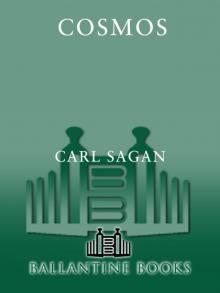 Cosmos
Cosmos Murmurs of Earth
Murmurs of Earth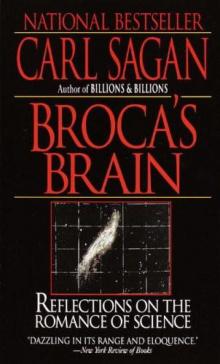 Broca's Brain
Broca's Brain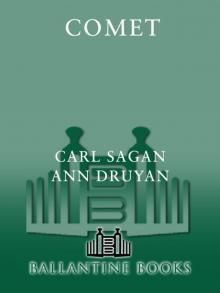 Comet
Comet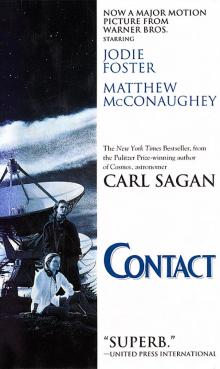 Contact
Contact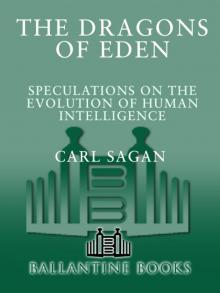 Dragons of Eden
Dragons of Eden Cosmic Connection
Cosmic Connection Shadows of Forgotten Ancestors
Shadows of Forgotten Ancestors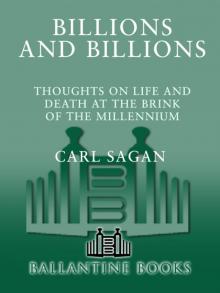 Billions & Billions
Billions & Billions Comet, Revised
Comet, Revised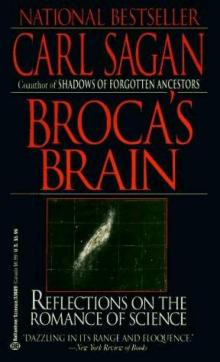 Broca's Brain: The Romance of Science
Broca's Brain: The Romance of Science The Varieties of Scientific Experience: A Personal View of the Search for God
The Varieties of Scientific Experience: A Personal View of the Search for God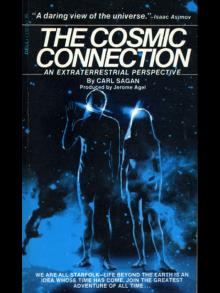 The Cosmic Connection
The Cosmic Connection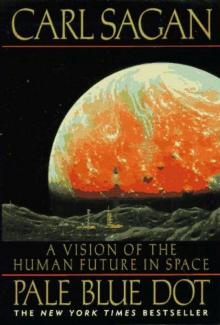 Pale Blue Dot: A Vision of the Human Future in Space
Pale Blue Dot: A Vision of the Human Future in Space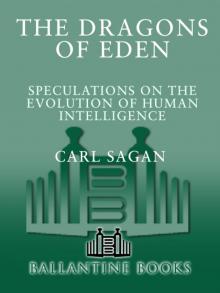 The Dragons of Eden
The Dragons of Eden